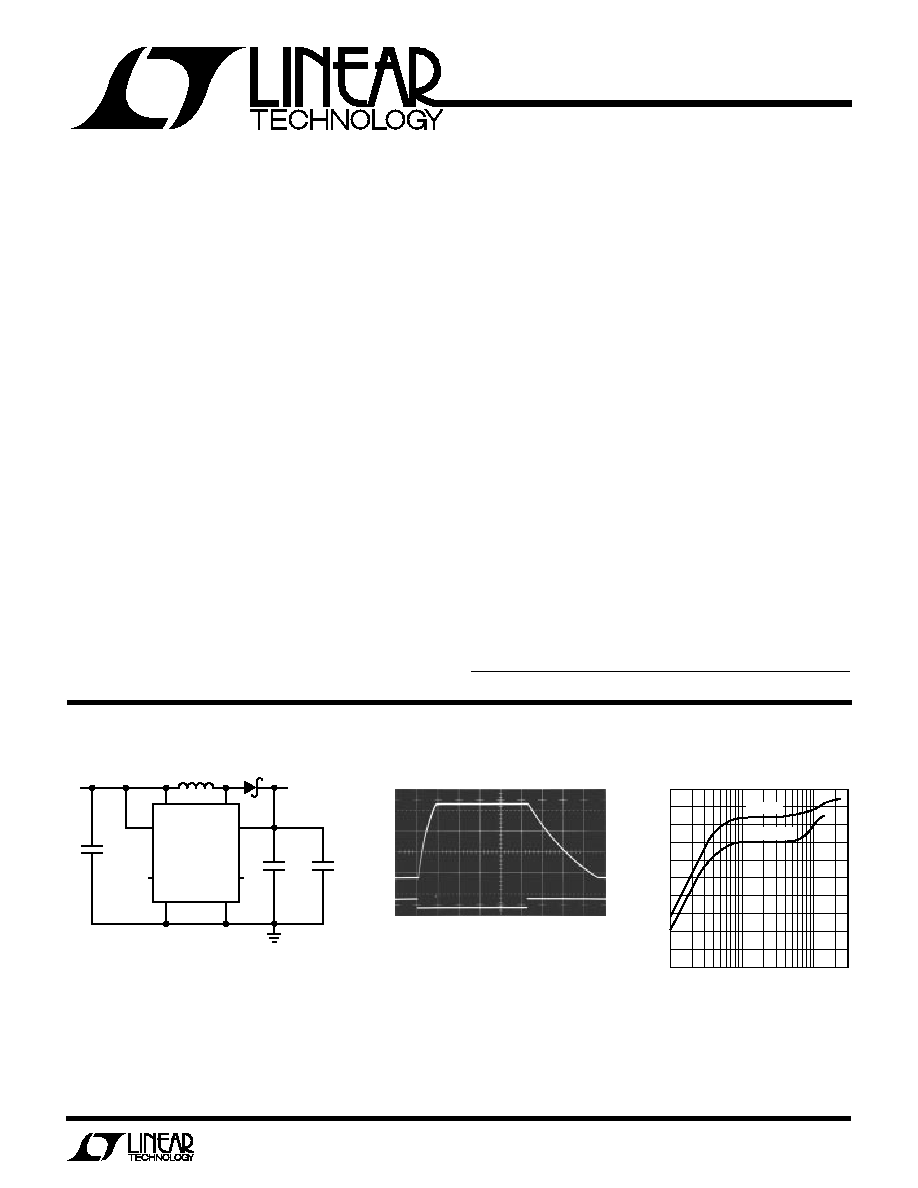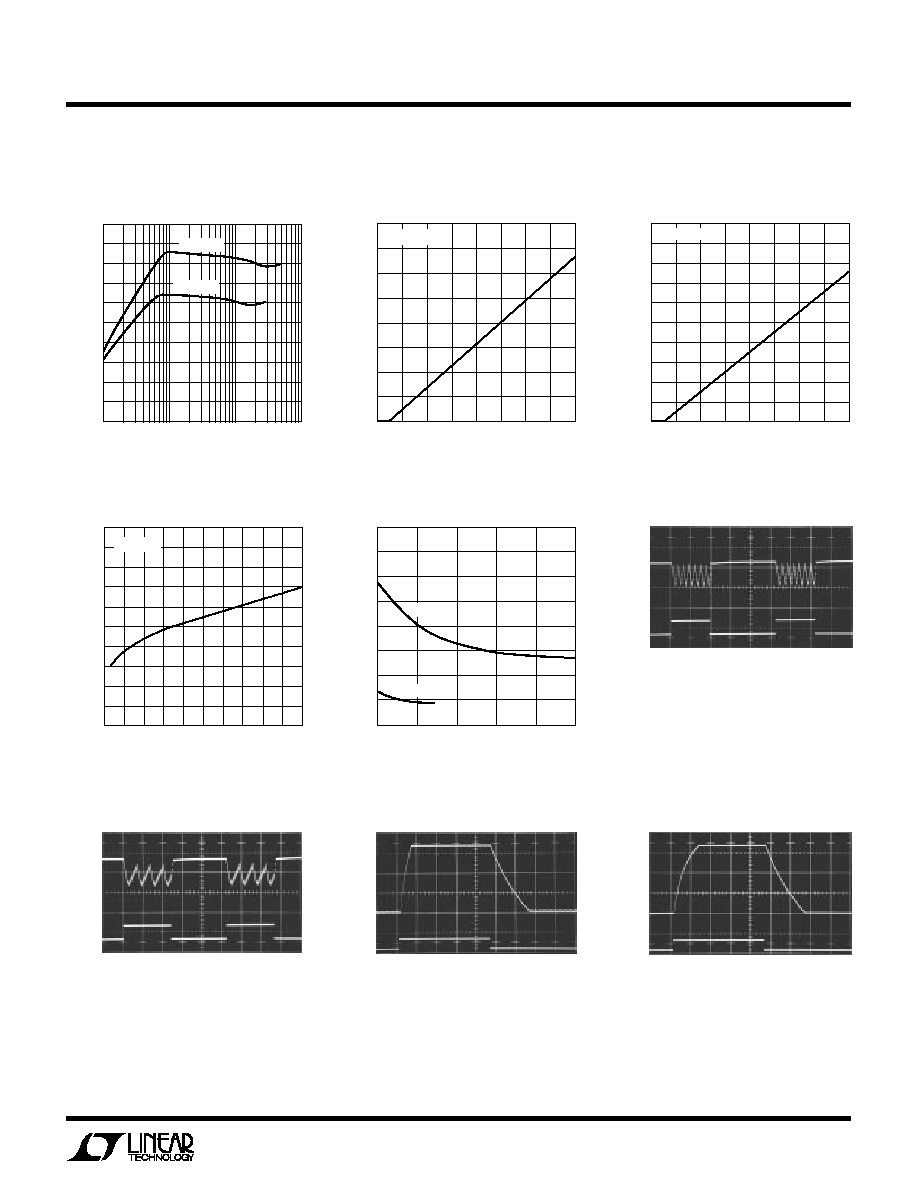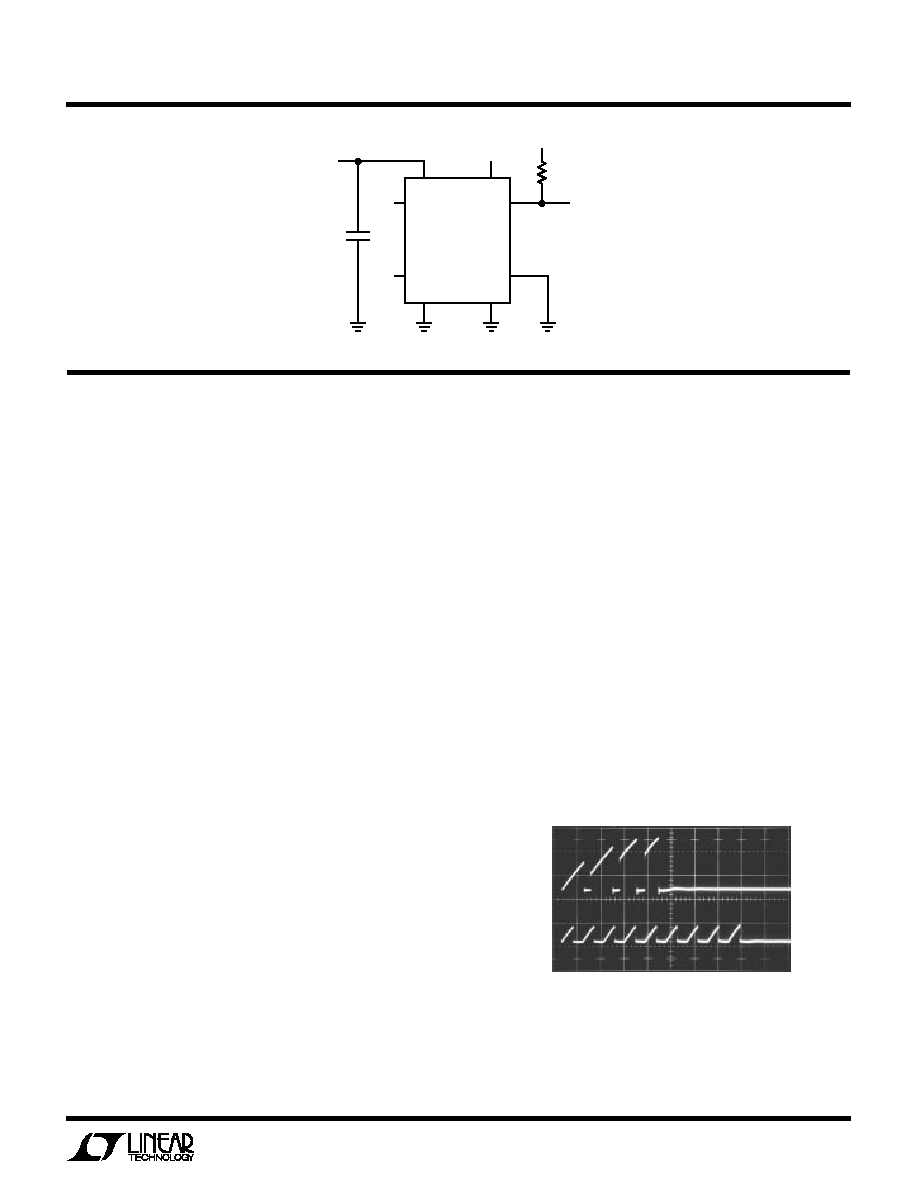 | –≠–ª–µ–∫—Ç—Ä–æ–Ω–Ω—ã–π –∫–æ–º–ø–æ–Ω–µ–Ω—Ç: LT1301 | –°–∫–∞—á–∞—Ç—å:  PDF PDF  ZIP ZIP |

1
LT1301
s
12V at 120mA from 5V or 3.3V Supply
s
Supply Voltage as Low as 1.8V
s
Better High Current Efficiency Than CMOS
s
Up to 89% Efficiency
s
120
µ
A Quiescent Current
s
Shutdown to 10
µ
A
s
Programmable 5V or 12V Output
s
Low V
CESAT
Switch: 170mV at 1A Typical
s
I
LIM
Pin Programs Peak Switch Current
s
Uses Inexpensive Surface Mount Inductors
s
8-Lead DIP or SOIC Package
s
Flash Memory V
PP
Generator
s
Palmtop Computers
s
Portable Instruments
s
Bar-Code Scanners
s
Personal Digital Assistants
s
PCMCIA Cards
The LT1301 is a micropower step-up DC/DC converter that
utilizes Burst ModeTM operation. The device can deliver 5V
or 12V from a two-cell battery input. It features program-
mable 5V or 12V output via a logic-controlled input, no-
load quiescent current of 120
µ
A and a shutdown pin which
reduces supply current to 10
µ
A. The on-chip power switch
has a low 170mV saturation voltage at a switch current of
1A, a four-fold reduction over prior designs. A 155kHz
internal oscillator allows the use of extremely small sur-
face mount inductors and capacitors. Operation is guaran-
teed at 1.8V input. This allows more energy to be extracted
from the battery, increasing operating life. The I
LIM
pin can
be used for soft start or to program peak switch current
with a single resistor allowing the use of even smaller
inductors in lighter load applications. The LT1301 is
available in an 8-lead SOIC package, minimizing board
space requirements. For a selectable 3.3V/5V step-up
converter, please see the LT1300. For higher output
power, see the LT1302.
DESCRIPTIO
N
U
FEATURES
TYPICAL APPLICATIO
N
S
N
U
Micropower High Efficiency
5V/12V Step-Up DC/DC
Converter for Flash Memory
APPLICATIO
N
S
U
LT1300 F2
Figure 1. 3.3V/5V to 12V Step-Up Converter
1ms/DIV
V
IN
= 5V, V
OUT
= 12V
LOAD = 100
Output Voltage
12V
V
OUT
2V/DIV
LT1301 TAO1
Efficiency
LOAD CURRENT (mA)
10
100
300
LT1301 TA2
1
0
72
74
EFFICIENCY (%)
76
78
80
82
90
84
86
88
V
IN
= 5V
V
IN
= 3.3V
L1 = COILCRAFT DO3316-333
OR SUMIDA CD73-330KC
D1 = 1N5817 OR MOTOROLA
MBRS130LT3
C1 = AVX TPSD476M016R0100
OR SANYO OS-CON 165A47M
C2 = AVX TPSD336M020R0100
OR SANYO OS-CON 205A33M
SHUTDOWN
10V/DIV
Burst Mode is a trademark of Linear Technology Corporation.
C2
33µF
20V
12V
OUTPUT
+
L1
33µH
D1
C1
47µF
SW
I
LIM
PGND
GND
SENSE
LT1301
SELECT
LT1301 F1
5V
OR
3.3V
SHDN
SHUTDOWN
N/C
V
IN
+
0.1µF*
*REQUIRED FOR 5V OUTPUT

2
LT1301
ABSOLUTE
M
AXI
M
U
M
RATINGS
W
W
W
U
PACKAGE/ORDER I
N
FOR
M
ATIO
N
W
U
U
V
IN
Voltage .............................................................. 10V
SW1 Voltage ............................................................ 20V
Sense Voltage .......................................................... 20V
Shutdown Voltage ................................................... 10V
Select Voltage .......................................................... 10V
I
LIM
Voltage ............................................................ 0.5V
Maximum Power Dissipation ............................. 500mW
Operating Temperature Range
LT1301C ................................................... 0
∞
C to 70
∞
C
LT1301I .................................................. 40
∞
C to 85
∞
C
Storage Temperature Range ................. ≠ 65
∞
C to 150
∞
C
Lead Temperature (Soldering, 10 sec).................. 300
∞
C
S8 PART MARKING
1301
1301I
SYMBOL
PARAMETER
CONDITIONS
MIN
TYP
MAX
UNITS
I
Q
Quiescent Current
V
SHDN
= 0.5V, V
SEL
= 5V, V
SENSE
= 5.5V
q
120
200
µ
A
V
SHDN
= 1.8V
q
7
15
µ
A
V
IN
Input Voltage Range
1.8
V
q
2.0
V
V
OUT
Output Sense Voltage
V
SEL
= 5V
q
11.52
12.00
12.48
V
V
SEL
= 0V
q
4.75
5.00
5.25
V
Output Referred
V
SEL
= 5V (Note 1)
q
50
100
mV
Comparator Hysteresis
V
SEL
= 0V (Note 1)
q
22
50
mV
Oscillator Frequency
Current Limit not Asserted.
120
155
185
kHz
Oscillator TC
0.2
%/
∞
C
DC
Maximum Duty Cycle
75
86
95
%
t
ON
Switch On-Time
Current Limit not Asserted.
5.6
µ
s
Output Line Regulation
1.8V < V
IN
< 6V
q
0.06
0.15
%/V
V
CESAT
Switch Saturation Voltage
I
SW
= 700mA
q
130
200
mV
Switch Leakage Current
V
SW
= 5V, Switch Off
q
0.1
10
µ
A
Peak Switch Current
I
LIM
Floating (See Typical Application)
0.75
1.0
1.25
A
(Internal Trip Point)
I
LIM
Grounded
0.4
A
V
SHDNH
Shutdown Pin High
q
1.8
V
V
SHDNL
Shutdown Pin Low
0.5
V
V
SELH
Select Pin High
q
1.5
V
V
SELL
Select Pin Low
q
0.8
V
I
SHDN
Shutdown Pin Bias Current
V
SHDN
= 5V
q
8
20
µ
A
V
SHDN
= 2V
q
3
µ
A
V
SHDN
= 0V
q
0.1
1
µ
A
I
SEL
Select Pin Bias Current
0V < V
SEL
< 5V
q
1
3
µ
A
ELECTRICAL CHARACTERISTICS
T
A
= 25
∞
C, V
IN
= 2V unless otherwise noted.
The
q
denotes specifications which apply over the 0
∞
C to 70
∞
C
temperature range.
ORDER PART
NUMBER
Note 1: Hysteresis specified is DC. Output ripple may be higher if
output capacitance is insufficient or capacitor ESR is excessive.
See operation section.
LT1301CN8
LT1301CS8
LT1301IS8
1
2
3
4
8
7
6
5
TOP VIEW
GND
SEL
SHDN
SENSE
PGND
SW
V
IN
I
LIM
N8 PACKAGE
8-LEAD PLASTIC DIP
S8 PACKAGE
8-LEAD PLASTIC SOIC
T
JMAX
= 100
∞
C,
JA
= 150
∞
C/ W

3
LT1301
5ms/DIV
TYPICAL PERFOR
M
A
N
CE CHARACTERISTICS
U
W
5V Output Efficiency
Shutdown Pin Bias Current
LOAD CURRENT (mA)
1
78
EFFICIENCY (%)
80
82
84
86
10
100
1000
LT1301 G1
76
74
72
70
88
90
V
IN
= 3.3V
V
IN
= 2.5V
200
µ
s/DIV
I
LOAD
120mA
0mA
V
OUT
100mV/DIV
AC COUPLED
LT1301 G6
V
OUT
100mV/DIV
AC COUPLED
120mA
0mA
I
LOAD
LT1301 G7
200
µ
s/DIV
V
OUT
2V/DIV
5V
V
SELECT
10V/DIV
C
OUT
= 100
µ
F, V
IN
= 5V
100
LOAD
LT1301 G8
V
SELECT
10V/DIV
5ms/DIV
LT1301 G9
C
OUT
= 100
µ
F, V
IN
= 3.3V
100
LOAD
Saturation Voltage vs Switch Current
No-Load Input Current
V
IN
= 5V
Load Transient Response of
Figure 1 Circuit
Total Quiescent Current
in Shutdown
SHUTDOWN VOLTAGE (V)
0
SHUTDOWN CURRENT (µA)
0
4
6
8
20
12
14
2
4
5
LT1300 G3
2
16
18
10
1
3
6
7
8
T
A
= 25∞C
INPUT VOLTAGE (V)
0
I
SHDN
+ I
VIN
+ I
SENSE
(µA)
40
50
60
8
LT1301 G2
30
20
0
2
4
6
10
80
70
1
3
5
7
T
A
= 25∞C
SWITCH CURRENT (A)
0
0.1
SATURATION VOLTAGE (mV)
150
175
200
225
250
0.8 0.9
LT1301 G4
100
125
50
25
75
0
0.2 0.3 0.4 0.5 0.6 0.7
1
T
A
= 25∞C
INPUT VOLTAGE (V)
2
INPUT CURRENT (µA)
250
300
350
5
7
LT1301 G5
200
150
100
3
4
6
400
450
500
V
OUT
= 12V
V
OUT
= 5V
Load Transient Response of
Figure 1 Circuit
V
IN
= 3.3V
12V
5V
12V
Select Pin Transient Response
Select Pin Transient Response
V
OUT
2V/DIV

4
LT1301
PI
N
FU
N
CTIO
N
S
U
U
U
GND (Pin 1): Signal Ground. Tie to PGND under the
package.
Sel (Pin 2): Output Select. When tied to V
IN
converter
regulates at 12V. When grounded or floating converter
regulates at 5V. May be driven under logic control.
SHDN (Pin 3): Shutdown. Pull high to shut down the
LT1301. Ground for normal operation.
Sense (Pin 4): "Output" Pin. Goes to internal resistive
divider. If operating at 5V output, a 0.1
µ
F ceramic capaci-
tor is required from Sense to Ground.
I
LIM
(Pin 5): Float for 1A switch current limit. Tie to ground
for approximately 400mA. A resistor between I
LIM
and
ground sets peak current to some intermediate value .
V
IN
(Pin 6): Supply Pin. Must be bypassed with a large
value electrolytic to ground. Keep bypass within 0.2" of the
device.
SW (Pin 7): Switch Pin. Connect inductor and diode here.
Keep layout short and direct to minimize radio frequency
interference.
PGND (Pin 8): Power Ground. Tie to signal ground (pin 1)
under the package. Bypass capacitor from V
IN
should be
tied directly to PGND within 0.2" of the device.
Figure 2.
BLOCK DIAGRA
M
W
OSCILLATOR
155kHZ
R2
730
C2
SW
R1
3
Q2
1
◊
Q1
160
◊
18mV
OFF
V
IN
V
IN
I
LIM
PGND
V
OUT
ENABLE
A1
COMPARATOR
≠
+
+
+
≠
+
1.25V
REFERENCE
L1
D1
7
2
4
SENSE
A2 CURRENT
COMPARATOR
A3 DRIVER
BIAS
Q3
8.5k
5
8
SHUTDOWN
3
SELECT
2
GND
69.2k
97.5k
500k
C1
1
LT1301 F2

5
LT1301
TEST CIRCUITS
Oscillator Test Circuit
2V
100
µ
F
V
IN
SEL
SENSE
GND
PGND
SHDN
SW
LT1301
I
L
100
5V
LT1301 TC
f
OUT
OPERATIO
N
U
Operation of the LT1301 is best understood by referring to
the Block Diagram in Figure 2. When A1's negative input,
related to the Sense pin voltage by the appropriate resis-
tor-divider ratio is higher that the 1.25V reference voltage,
A1's output is low. A2, A3 and the oscillator are turned off,
drawing no current. Only the reference and A1 consume
current, typically 120
µ
A. When A1's negative input drops
below 1.25V, overcoming A1's 6mV hysteresis, A1's out-
put goes high enabling the oscillator, current comparator
A2, and driver A3. Quiescent current increases to 2mA as
the device prepares for high current switching. Q1 then
turns on in controlled saturation for (nominally) 5.3
µ
s or
until comparator A2 trips, whichever comes first. After a
fixed off-time of (nominally) 1.2
µ
s, Q1 turns on again. The
LT1301's switching causes current to alternately build up
in L1 and dump into output capacitor C2 via D1, increasing
the output voltage. When the output is high enough to
cause A1's output to go to low, switching action ceases.
C2 is left to supply current to the load until V
OUT
decreases
enough to force A1's output high, and the entire cycle
repeats. Figure 4 details relevant waveforms. A1's cycling
causes low-to-mid-frequency ripple voltage on the output.
Ripple can be reduced by making the output capacitor
large. The 33
µ
F unit specified results in ripple of 100mV to
200mV on the 12V output. A 100
µ
F capacitor will decrease
ripple to 50mV. If operating at 5V ouput a 0.1
µ
F ceramic
capacitor is required at the Sense pin in addition to the
electrolytic.
If switch current reaches 1A, causing A2 to trip, switch on-
time is reduced and off-time increases slightly. This allows
continuous mode operation during bursts. A2 monitors
the voltage across 3
resistor R1 which is directly related
to the switch current. Q2's collector current is set by the
emitter-area ratio to 0.6% of Q1's collector current. When
R1's voltage drop exceeds 18mV, corresponding to 1A
switch current, A2's output goes high, truncating the on-
time portion of the oscillator cycle and increasing off-time
to about 2
µ
s as shown in Figure 3, trace A. This pro-
grammed peak current can be reduced by tying the I
LIM
pin
to ground, causing 15
µ
A to flow through R2 into Q3's
collector. Q3's current causes a 10.4mV drop in R2 so that
only an additional 7.6mV is required across R1 to turn off
the switch. This corresponds to a 400mA switch current
as shown in Figure 3, trace B. The reduced peak switch
current reduces I
2
R loses in Q1, L1, C1 and D1. Efficiency
can be increased by doing this provided that the accom-
panying reduction in full load current is acceptable. Lower
peak currents also extend alkaline battery life due to the
alkaline cell's high internal impedance.
Figure 3. Switch Pin Current With I
LIM
Floating or Grounded
TRACE A
500mA/DIV
I
LIM
PIN
OPEN
TRACE B
500mA/DIV
I
LIM
PIN
GROUNDED
20
µ
s/DIV




